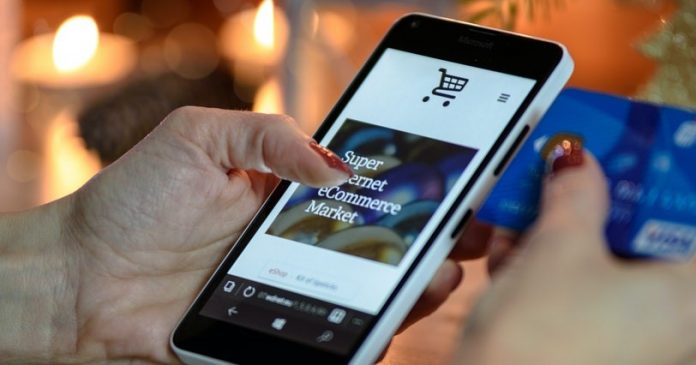
The business and e-commerce landscape has significantly shifted during the COVID-19 social isolation period as more purchases have shifted from brick and mortar environments to digital channels.
Adobe Analytics monitors 80 of the top 100 U.S retailers and they found strong surges in March 13 to 15, a 25% increase on the start of the first 11 days of the month. Of course, much of this would have been as a result of consumers stocking up on necessities such as pantry items, toilet paper and hand sanitizer. Nevertheless, e-commerce transactions are expected to become stronger even in the post COVID-19 environment as consumers have become more accustomed to shopping online.
This includes proportions of the population that previous to COVID-19 may have rarely or never even shop online. Using a longer view, grocery spending now represents 8% of overall e-commerce, up from 6% three years ago, which although not sounding huge on paper perhaps actually represents a one-third increase in just 3 years.
Here’s a look at the top 10 implications for e-Commerce from COVID-19:
- Businesses Pivoting
Already we have seen a lot of pivoting by businesses to meet the demands of consumers. For example, some alcohol distilleries chose to instead supply hand sanitizers and sell them online.
Other businesses have shifted to sourcing and supplying essential ingredients for example to better satisfy the market. This will result in market dynamics changing as new entrants come in while some move out.
The most common pivot we have seen is businesses moving from physical to digital channels. In fact 100,000 stores in the US could close by 2025 according to UBS researchers’ forecasts. Already there have been some businesses that have completely removed physical stores and completely shifted to online presences only.
Omnichannel options will need to be considered by businesses if not already offering as well as how they can improve these experiences. For example, many businesses provide the option of in-store pick up to customers if they need something quickly for example and don’t want to wait for delivery.
Physical stores can help to connect with your customers and provide a branded experience complementing digital channels. Some companies have spent significant money on flagship stores with excellent updated customer experiences for example while reducing the overall store footprint and moving more to online channels.
- Business Technology Spend
Business’ technology spend will increase to meet the consumers demands for more purchases online. For existing businesses with e-commerce presences, improvements may include extending the product range, extending online services and providing improved functionality to users. Further, infrastructure may need to be upgraded to handle larger transaction volumes.
- More Intense Competition
Competition will be more intense than ever especially as large companies double down on digital transformations and technology upgrades to significantly improve their online presence. A greater number of new entrants are likely from businesses that want to take advantage of the accelerated shift to online purchases.
- Businesses Will Need to Improve Customer Experiences
Businesses will need to leverage technology such as virtual reality, video technology and so forth to enrich the customer journey online. For example, virtual reality can allow the customer to get a better idea of the product or service through a richer visual experience.
Ikea is already using augmented reality apps for customers to visualize 3D versions of furniture inside homes. Video technology could enable staff to engage with customers ‘face to face’ building the relationship with customers and enabling more comprehensive conversations.
In a highly competitive market businesses will need to differentiate themselves and market leaders will need to be adopting or even creating the latest technologies. Customers will become more experienced and discerning as online customers.
- Digital Customer Service
Messaging App adoption from customers will mean chatbots in various channels will keep rising in popularity. They can place and cancel orders, handle customer queries and even deliver personal shopping experiences.
Real-time customer assistance will be looked upon highly by consumers and its expected the human customer service team will quickly pick up any more complex queries which cannot be handled by technology. Staples partnered with IBM’s Watson to create its intelligent Easy System. This allows Staples’ Facebook Messenger bot to answer many common customer questions, even about their orders such as tracking and returns, as well as which items are in stock.
Those companies that are not using chatbots and messaging apps or to their full potential, should consider implementing and have them deal with as many queries as possible. This then reduces the pressure on customer service teams to handle a large volume of customer queries. They can focus on more complex queries and potentially clients that are more likely to bring larger amounts of business. Response times will also improve as a result.
- Integration of Product with Technology will Occur
Increased consumer demand for great digital experiences will result in companies integrating technology with physical product more. For example, the washing detergent brand OMO partnered with J Walter Thompson to create what they argue is the world’s smartest clothes peg.
Named ‘Peggy’, light, humidity and temperature sensors, with a WI-FI module can provide consumers with the ideal time to do washing. Weather data and forecasting for the user’s location is utilized. Users can see on their mobile a weather summary and even an approximate finished drying time based on the weather.
Smart kitchens and appliances are another example of products integrating with technology to improve customer experiences.
QR codes on products is another example where companies are using technology to provide a better experience for customers. Tie ups between technology companies and brands selling physical products will continue to increase.
It is expected more of these products will be conceived as consumers will become more technology savvy and demand these kinds of technology upgrades.
- Digital Streaming
Digital streaming will continue to grow in popularity especially as new customers have become accustomed to viewing Netflix, Amazon Prime, Disney and so forth during this period. Major providers will have to continue to proliferate great content and potentially add new functionality to improve the streaming experience for customers.
Perhaps initially and more importantly especially for companies experiencing strong growth, streaming companies will need to consider upgrading their technology infrastructure for a ‘new normal’. Network infrastructure needs to support high levels of demand and greater levels of content needing to be delivered. Recently, Netflix needed to reduce bit rates in some European markets to reduce the impact on network infrastructure and enable customers to still enjoy video content, albeit at a lower quality.
- Subscription-based and Automated Reordering
With the move to more e-commerce transactions it is expected the popularity of subscription-based and automated reordering services and options will increase. For example, with grocery shopping being done more at home regular purchases such as milk, bread and so forth will become part of the weekly delivery. This will provide improved convenience for customers however businesses will need to respond by providing these services and making it easy for customers to set up these services and make changes.
Subscription based shopping has grown by 800% since 2014 with everything from groceries, beauty products, clothes for work and toys for pets being sent regularly to consumers to provide convenience, provide variety by updating their offering regularly and aligning better to the customers preferences.
- Mobile Optimization
Consumers will increasingly want more convenient options to do their online shopping so mobile devices will continue to be popular. It is expected mobile purchases will continue to increase so companiess must create great mobile optimized purchasing experiences. This may include investment in building or improving their apps and websites for a better customer experience on smartphones.
For example, e-commerce businesses currently may ascertain which products the customers are interested in through web traffic to create personalized recommendations of what other complementing products and services the customer may prefer.
With people increasingly demanding fast, convenient checkout businesses will need to ensure payments functionality is aligned. For example, presenting customers with mobile-first payment options allowing purchase with a single click. Optionality to remember personal and credit card details but with security built in (e.g. 4-digit pins) are also expected. However, it is expected these technologies will improve further as customer demands and traffic to sites increase.
- Social Media
Social media’s popularity will continue however companies will look at more improved ways to integrate social media channels with smooth purchases. 9 out of 10 consumers turn to social media to assist them with buying decisions already.
Social media companies such as Instagram already have shopping posts where products are tagged in posts by companies selling products. This brings social media closer to e-commerce and facilitates more convenient transactions for customers.
They have even brought in their own augmented reality shopping features to enable customers to try on products before deciding to purchase. For example, NARS dressed to kill lipsticks augmented VR offering to customers on Instagram allowed customers to try on different lipstick colors to determine what suited them best.
There will also likely to be new entrants to the social media space that will look to not only find ways to continue to monetize through advertising for example but also invent new ways for seamless e-commerce to occur.
Without a doubt, COVID-19 has forced many businesses to change their business models and approach to e-commerce. Businesses must be proactive in carefully considering their sales strategies and consider investing in technology to improve experiences for their customers.
It’s time to be re-evaluating your entire e-commerce strategy.
Bio:
Simon Choi is an e-commerce owner for niche photography business, Refractique and recently established Standout Bands, a third-party Apple Watch Bands retailer. He has a change management corporate consulting background. He lives in Melbourne, Australia and writes regularly in business and psychology. Connect with Simon on LinkedIn.











